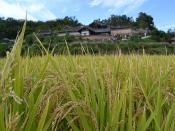Charles Dunn's book Everyday Life in Traditional Japan is extremely detailed in every aspect of Tokugawa Japan. It portrays Japanese society as divided by social classes, but also I think it was this particular division that made Japan the cohesive nation that it was. Dunn also portrays how each class was divided within itself and how it was also a well oiled machine.
The importance's of each class in Japan at the time was different as we would see it in the western approach to it. The farmers were probably the single most important social class, which also comprised of the most population. The farmers grew the rice, which made the country run. Everything was based on rice, currency, wages, and most importantly power. The rice would be grown by villages that were controlled by a higher lord that would let the farmers keep a portion of the rice they grew, but as in all societies these farmers hoarded rice.
Tokugawa Japan was so well organized that it accounted for everything, the hoarding of rice and the loss of grain through transport. Now within the farmer class they had their own division, mainly between genders. The men would do the work of growing the rice and cultivating it, but the women were the ones that would plant the rice initially. The women in the farming community were constantly busy, raising children, cooking, cleaning, and they were in charge of textile production of silk through the tending of silk worms constantly. Then it was the samurai which were sort of like the police of the nation. There were many different types of samurai some were teachers in local villages that taught their skill to other samurai pupils, you could only be a samurai if you were hereditarily born into it.


